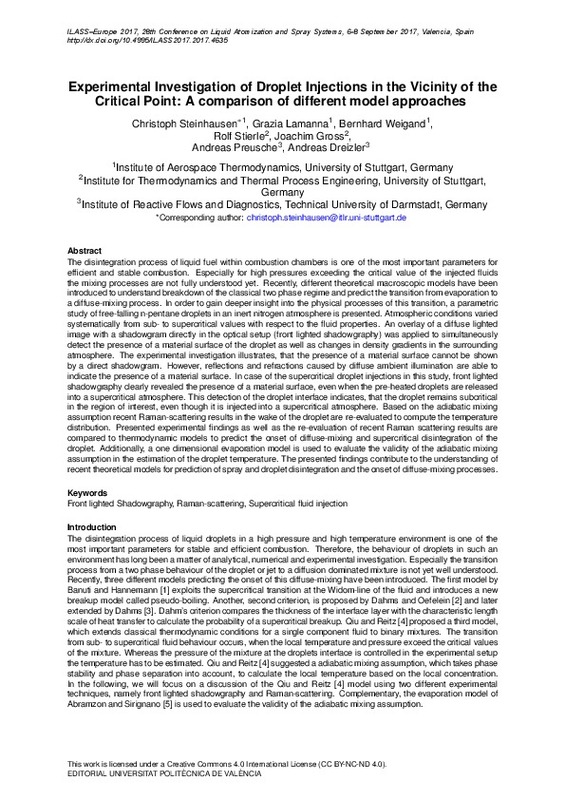JavaScript is disabled for your browser. Some features of this site may not work without it.
Buscar en RiuNet
Listar
Mi cuenta
Estadísticas
Ayuda RiuNet
Admin. UPV
Experimental Investigation of Droplet Injections in the Vicinity of the Critical Point: A comparison of different model approaches
Mostrar el registro sencillo del ítem
Ficheros en el ítem
| dc.contributor.author | Steinhausen, Christoph
|
es_ES |
| dc.contributor.author | Lamanna, Grazia
|
es_ES |
| dc.contributor.author | Weigand, Bernhard
|
es_ES |
| dc.contributor.author | Stierle, Rolf
|
es_ES |
| dc.contributor.author | Groß, Joachim
|
es_ES |
| dc.contributor.author | Preusche, Andreas
|
es_ES |
| dc.contributor.author | Dreizler, Andreas
|
es_ES |
| dc.date.accessioned | 2018-03-29T10:07:21Z | |
| dc.date.available | 2018-03-29T10:07:21Z | |
| dc.date.issued | 2017-07-28 | |
| dc.identifier.isbn | 9788490485804 | |
| dc.identifier.uri | http://hdl.handle.net/10251/99927 | |
| dc.description.abstract | [EN] The disintegration process of liquid fuel within combustion chambers is one of the most important parameters for efficient and stable combustion. Especially for high pressures exceeding the critical value of the injected fluids the mixing processes are not fully understood yet. Recently, different theoretical macroscopic models have been introduced to understand breakdown of the classical two phase regime and predict the transition from evaporation to a diffuse-mixing process. In order to gain deeper insight into the physical processes of this transition, a parametric study of free-falling n-pentane droplets in an inert nitrogen atmosphere is presented. Atmospheric conditions varied systematically from sub- to supercritical values with respect to the fluid properties. An overlay of a diffuse lighted image with a shadowgram directly in the optical setup (front lighted shadowgraphy) was applied to simultaneously detect the presence of a material surface of the droplet as well as changes in density gradients in the surrounding atmosphere. The experimental investigation illustrates, that the presence of a material surface cannot be shown by a direct shadowgram. However, reflections and refractions caused by diffuse ambient illumination are able to indicate the presence of a material surface. In case of the supercritical droplet injections in this study, front lighted shadowgraphy clearly revealed the presence of a material surface, even when the pre-heated droplets are released into a supercritical atmosphere. This detection of the droplet interface indicates, that the droplet remains subcritical in the region of interest, even though it is injected into a supercritical atmosphere. Based on the adiabatic mixing assumption recent Raman-scattering results in the wake of the droplet are re-evaluated to compute the temperature distribution. Presented experimental findings as well as the re-evaluation of recent Raman scattering results are compared to thermodynamic models to predict the onset of diffuse-mixing and supercritical disintegration of the droplet. Additionally, a one dimensional evaporation model is used to evaluate the validity of the adiabatic mixing assumption in the estimation of the droplet temperature. The presented findings contribute to the understanding of recent theoretical models for prediction of spray and droplet disintegration and the onset of diffuse-mixing processes. | es_ES |
| dc.description.sponsorship | The authors gratefully acknowledge the German Research Foundation (DFG) for the financial support through the collaborative research centre SFB/Transregio 75. | es_ES |
| dc.format.extent | 8 | es_ES |
| dc.language | Inglés | es_ES |
| dc.publisher | Editorial Universitat Politècnica de València | es_ES |
| dc.relation.ispartof | Ilass Europe. 28th european conference on Liquid Atomization and Spray Systems | es_ES |
| dc.rights | Reconocimiento - No comercial - Sin obra derivada (by-nc-nd) | es_ES |
| dc.subject | Front lighted Shadowgraphy | es_ES |
| dc.subject | Raman-scattering | es_ES |
| dc.subject | Supercritical fluid injection | es_ES |
| dc.title | Experimental Investigation of Droplet Injections in the Vicinity of the Critical Point: A comparison of different model approaches | es_ES |
| dc.type | Capítulo de libro | es_ES |
| dc.type | Comunicación en congreso | es_ES |
| dc.identifier.doi | 10.4995/ILASS2017.2017.4635 | |
| dc.rights.accessRights | Abierto | es_ES |
| dc.description.bibliographicCitation | Steinhausen, C.; Lamanna, G.; Weigand, B.; Stierle, R.; Groß, J.; Preusche, A.; Dreizler, A. (2017). Experimental Investigation of Droplet Injections in the Vicinity of the Critical Point: A comparison of different model approaches. En Ilass Europe. 28th european conference on Liquid Atomization and Spray Systems. Editorial Universitat Politècnica de València. 830-837. https://doi.org/10.4995/ILASS2017.2017.4635 | es_ES |
| dc.description.accrualMethod | OCS | es_ES |
| dc.relation.conferencename | ILASS2017 - 28th European Conference on Liquid Atomization and Spray Systems | es_ES |
| dc.relation.conferencedate | September 06-08,2017 | es_ES |
| dc.relation.conferenceplace | Valencia, Spain | es_ES |
| dc.relation.publisherversion | http://ocs.editorial.upv.es/index.php/ILASS/ILASS2017/paper/view/4635 | es_ES |
| dc.description.upvformatpinicio | 830 | es_ES |
| dc.description.upvformatpfin | 837 | es_ES |
| dc.type.version | info:eu-repo/semantics/publishedVersion | es_ES |
| dc.relation.pasarela | OCS\4635 | es_ES |
| dc.contributor.funder | Deutsche Forschungsgemeinschaft |








